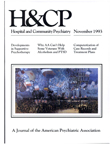Staffing Patterns in Rural Community Support Programs
Abstract
Rural mental health programs are thought to have difficulty recruiting and retaining qualified staff and to have excessively large caseloads per staff member. The authors surveyed 12 community support programs in small cities and rural areas of Wisconsin to determine staff size and characteristics, staff-to-client ratios, and the relative use of paraprofessional staff and professional staff excluding psychiatrists. Results: The programs surveyed had an average of 5.6 full-time-equivalent caregiving staff and an average caregiver-to-client ratio of 1 to 13. Caregiving staff were predominantly female, had been in the mental health field a mean of 8.8 years, and received an average salary of $20,732. Although program directors indicated that about one-fifth of staff left in the previous year, they reported little difficulty recruiting staff Thirty-eight percent of all caregivers were paraprofessionals; in several programs, more than half the caregivers were paraprofessionals. Use of paraprofessionals is more common in rural programs; thus caregivers in those programs are likely to have lower levels of salary and experience. Conclusions: The community support programs in the sample employed experienced caregivers and had staff-to-client ratios that were close to the ratio recommended for such programs by Wisconsin legislation. The survey findings suggest that claims of acute staffing problems in rural community support programs need to be examined more closely, with attention to the relationship between staff characteristics and client outcomes.
Access content
To read the fulltext, please use one of the options below to sign in or purchase access.- Personal login
- Institutional Login
- Sign in via OpenAthens
- Register for access
-
Please login/register if you wish to pair your device and check access availability.
Not a subscriber?
PsychiatryOnline subscription options offer access to the DSM-5 library, books, journals, CME, and patient resources. This all-in-one virtual library provides psychiatrists and mental health professionals with key resources for diagnosis, treatment, research, and professional development.
Need more help? PsychiatryOnline Customer Service may be reached by emailing [email protected] or by calling 800-368-5777 (in the U.S.) or 703-907-7322 (outside the U.S.).



